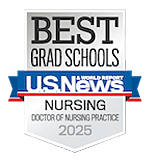Multi-factorial strategies for sustaining safe patient handling: An evidence-based doctor of nursing practice demonstration project
Project Background
A significant gap exists in patient handling strategies and the use of evidence- based practices to reduce musculoskeletal injuries (MSIs). In 2015, the Bureau of Labor Statistics determined that Registered Nurses (RN) incurred 10, 290 MSIs, among the highest incidences of MSIs for U.S. healthcare workers. Using a pre and post design in an academic hospital setting, the aim of this pilot included implementation of an evidence-based, multifactorial safe patient handling and movement (SPHM) program to evaluate the impact on staff MSIs attributed to patient handling.
Project Purpose
The aims of this evidence-based demonstration pilot include:
Implementation of an evidence-based, multifactorial safe patient handling and movement (SPHM) program and evaluate the impact on staff injuries attributed to patient handling responsibilities. Outcome measures include staff injuries, days away from work and days of modified work days attributed to patient handling.
Assessment of appropriateness of RN use of the perioperative lateral transfer algorithm to ensure compliance with the National Institute for Occupational Health and Safety (NIOSH) 35-pound weight limit for patient handling activities. Outcome measures include correct use of the decision algorithm checklist for perioperative lateral transfers.
Evaluation of the staff’s perceived usefulness and intent to use air- assisted lateral transfer technology, in comparison with the slider board, to prevent patient handling injuries.
Project Methods
Using a pre and post design in an academic hospital setting, this eight-month pilot included use of the National Institute for Occupational Safety and Health (NIOSH) 35-pound lifting limit for patient handling activities. This was achieved by providing a unit-based SPHM coach, a decision algorithm for lateral patient transfers, and an air-assisted lateral transfer device within the perioperative setting.
Moderate evidence supports the use of multifactorial SPHM programs in reducing MSIs. Statistically significant reductions in nursing MSIs have occurred with the use of a multifactorial, evidence-based approach to (SPHM) that included engineering controls such as air-assisted lateral transfer devices, behavior controls, including unit-based SPHM peer coaches and administrative controls (e.g., decision algorithms). The conceptual framework guiding this pilot was the Iowa Model of Evidenced-Based Practice (EBP) to Promote Quality Care.
Project Outcomes
Participants in this multifactorial SPHM pilot did not experience patient handling injuries, days away from work, or modified work days attributed to patient handling activities during the six-month pilot. There were two RNs injured during patient handling activities on the non-pilot units. Results support findings that the use of multifactorial SPHM programs reduce nursing staff MSIs attributed to patient handling.
The perioperative lateral transfer algorithm was determined to be appropriate 88% of the time used, except for patients who would be placed into the Trendelenburg or reverse Trendelenburg positions.
Upon completion of the six-month pilot, there was a significantly greater intent to use the HoverMatt® (p= .000081) than the slider board. Moreover, the perceived usefulness of the HoverMatt® was significantly greater (p = .000169) than the slider board. The larger the value of t, as shown for intent to use and usefulness, the more pronounced the difference between the conditions.
Project Implications
Additional studies should examine the long-term impact on SPHM policies in reducing and sustaining reductions in patient handling injuries. Are the policies effective in reducing injuries from high-risk patient handling activities (e.g. bariatric patients) or in supporting injury reductions in an aging nursing workforce? Does the use of SPHM peer coach activity summaries at monthly unit meetings, in collaboration with unit supervision, help to sustain SPHM policy requirements and ideally, reductions in patient handling injuries?





